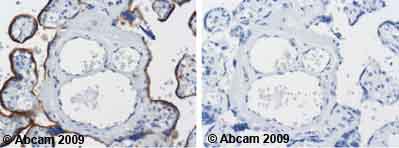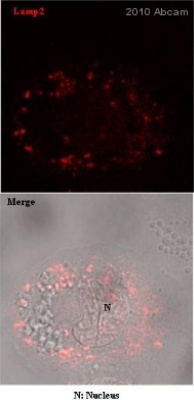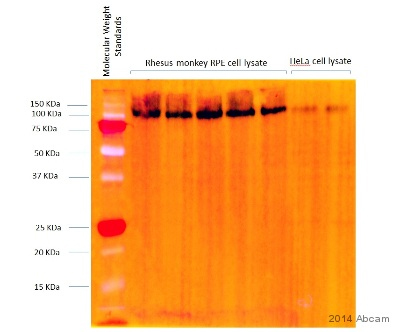Anti-LAMP2 antibody [H4B4]
| Name | Anti-LAMP2 antibody [H4B4] |
|---|---|
| Supplier | Abcam |
| Catalog | ab25631 |
| Prices | $401.00 |
| Sizes | 100 µg |
| Host | Mouse |
| Clonality | Monoclonal |
| Isotype | IgG1 |
| Clone | H4B4 |
| Applications | FC IHC-F ICC/IF WB IHC-P ICC/IF ICC/IF IHC-F |
| Species Reactivities | Human, Monkey, Monkey |
| Antigen | The details of the immunogen for this antibody are not available |
| Description | Mouse Monoclonal |
| Gene | LAMP2 |
| Conjugate | Unconjugated |
| Supplier Page | Shop |
Product images
Product References
Amino acids activate mammalian target of rapamycin (mTOR) complex 1 without - Amino acids activate mammalian target of rapamycin (mTOR) complex 1 without
Oshiro N, Rapley J, Avruch J. J Biol Chem. 2014 Jan 31;289(5):2658-74.
Quantitative proteomics identifies NCOA4 as the cargo receptor mediating - Quantitative proteomics identifies NCOA4 as the cargo receptor mediating
Mancias JD, Wang X, Gygi SP, Harper JW, Kimmelman AC. Nature. 2014 May 1;509(7498):105-9.
The tumor susceptibility gene TMEM127 is mutated in renal cell carcinomas and - The tumor susceptibility gene TMEM127 is mutated in renal cell carcinomas and
Qin Y, Deng Y, Ricketts CJ, Srikantan S, Wang E, Maher ER, Dahia PL. Hum Mol Genet. 2014 May 1;23(9):2428-39.
Basal body proteins regulate Notch signaling through endosomal trafficking. - Basal body proteins regulate Notch signaling through endosomal trafficking.
Leitch CC, Lodh S, Prieto-Echague V, Badano JL, Zaghloul NA. J Cell Sci. 2014 Jun 1;127(Pt 11):2407-19.
Macrophage models of Gaucher disease for evaluating disease pathogenesis and - Macrophage models of Gaucher disease for evaluating disease pathogenesis and
Aflaki E, Stubblefield BK, Maniwang E, Lopez G, Moaven N, Goldin E, Marugan J, Patnaik S, Dutra A, Southall N, Zheng W, Tayebi N, Sidransky E. Sci Transl Med. 2014 Jun 11;6(240):240ra73.
Ras transformation uncouples the kinesin-coordinated cellular nutrient response. - Ras transformation uncouples the kinesin-coordinated cellular nutrient response.
Zaganjor E, Weil LM, Gonzales JX, Minna JD, Cobb MH. Proc Natl Acad Sci U S A. 2014 Jul 22;111(29):10568-73. doi:
Familial globotriaosylceramide-associated cardiomyopathy mimicking Fabry disease. - Familial globotriaosylceramide-associated cardiomyopathy mimicking Fabry disease.
Apelland T, Gude E, Strom EH, Gullestad L, Eiklid KL, Mansson JE, Reinholt FP, Houge G, Dahl CP, Almaas VM, Heiberg A. Heart. 2014 Nov;100(22):1793-8.
The rough endoplasmatic reticulum is a central nucleation site of siRNA-mediated - The rough endoplasmatic reticulum is a central nucleation site of siRNA-mediated
Stalder L, Heusermann W, Sokol L, Trojer D, Wirz J, Hean J, Fritzsche A, Aeschimann F, Pfanzagl V, Basselet P, Weiler J, Hintersteiner M, Morrissey DV, Meisner-Kober NC. EMBO J. 2013 Apr 17;32(8):1115-27.
Cellular uptake mechanism and intracellular fate of hydrophobically modified - Cellular uptake mechanism and intracellular fate of hydrophobically modified
Jiang L, Li X, Liu L, Zhang Q. Int J Nanomedicine. 2013;8:1825-34.
Hsp70 inhibition induces myeloma cell death via the intracellular accumulation of - Hsp70 inhibition induces myeloma cell death via the intracellular accumulation of
Zhang L, Fok JJ, Mirabella F, Aronson LI, Fryer RA, Workman P, Morgan GJ, Davies FE. Cancer Lett. 2013 Oct 1;339(1):49-59.



![Anti-LAMP2 antibody [H4B4] (ab25631) at 1/500 dilution + whole cell lysate prepared from THP-1 macrophages at 30 µgSecondaryGoat anti-mouse IgG conjugated to HRP at 1/2000 dilutiondeveloped using the ECL techniqueObserved band size : 110 kDa (why is the actual band size different from the predicted?)Exposure time : 30 secondsThis image was kindly supplied by Daniel Rodriguez by AbreviewPrimary antibody incubated for 12 hours at 4°C.Gel running conditions: 12%Blocked with 5% milk for 1 hour at 25°C.See Abreview](http://www.bioprodhub.com/system/product_images/ab_products/2/sub_3/15011_LAMP2-Primary-antibodies-ab25631-7.jpg)
![Overlay histogram showing THP1 cells stained with ab25631 (red line). The cells were fixed with 4% paraformaldehyde (10 min) and then permeabilized with 0.1% PBS-Tween for 20 min. The cells were then incubated in 1x PBS / 10% normal goat serum / 0.3M glycine to block non-specific protein-protein interactions followed by the antibody (ab25631, 0.5µg/1x106 cells) for 30 min at 22°C. The secondary antibody used was DyLight® 488 goat anti-mouse IgG (H+L) (ab96879) at 1/500 dilution for 30 min at 22°C. Isotype control antibody (black line) was mouse IgG1 [ICIGG1] (ab91353, 2µg/1x106 cells) used under the same conditions. Acquisition of >5,000 events was performed. This antibody gave a positive signal in THP1 cells fixed with methanol (5 min)/permeabilized in 0.1% PBS-Tween used under the same conditions.](http://www.bioprodhub.com/system/product_images/ab_products/2/sub_3/15012_LAMP2-Primary-antibodies-ab25631-9.jpg)
